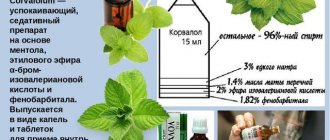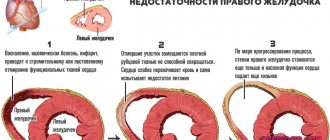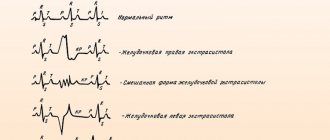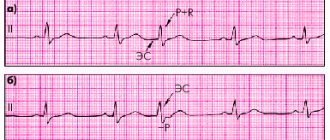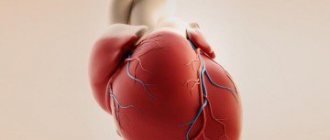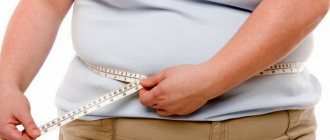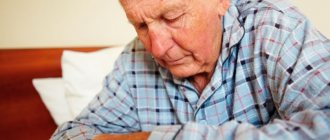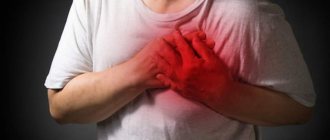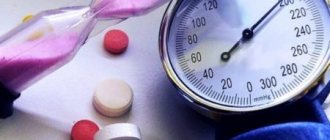Symptoms
In most cases, functional extrasystole with bradycardia has no symptoms. Sometimes manifestations do occur, their intensity and frequency depend on the degree of pathology, type, and individual characteristics of the human body. Extrasystole is often a symptom of another disease of the internal organs and systems of the body. In this case, the manifestations of one pathology are intertwined with the symptoms of another.
Common symptoms of the anomaly:
- dizziness;
- decreased heart rate;
- increased sweating;
- excessive irritability;
- short-term cardiac arrest;
- a feeling of interruptions in the work of the heart;
- lack of air;
- general weakness;
- blood pressure surges;
- increased anxiety;
- low heart rate;
- tremors in the chest;
- an unreasonable feeling of fear.
Symptoms of ventricular extrasystole with bradycardia
The main symptom is a decrease in heart rate (heart rate). It decreases, alternating with the norm, or does not rise higher. Against this background, pressure surges are observed, while the clinic returns to normal at rest. In a state of activity, manifestations of extrasystole are practically invisible. They are perceptible only in a state of rest. And the lower the pulse, the more clearly they appear.
How do patients characterize the sensations? It seems to them that something is interfering with the heart; lying on the left side is difficult, as the symptoms worsen. There is an illusion of an air sac supporting the heart. You also feel heart palpitations, fatigue, and dizziness. Bradycardia may be a harbinger of a more serious pathology. And it goes away after treatment is carried out.
Treatment of pathology
Extrasystoles of a neurogenic nature often occur in young and healthy people. Single and rare impulses outside the sinus node do not pose a serious threat to health and do not require specialized treatment. It is enough to follow the general recommendations and lead a healthy lifestyle. In this case, self-medication is strictly contraindicated, since arrhythmic drugs will do more harm than good.
If extrasystoles during bradycardia are multiple, group, occur too often, as well as with individual intolerance to the symptoms of the pathology, the doctor prescribes treatment, taking into account the specific features of the disease and the general condition of the patient. In the absence of adequate therapy, there is a possibility of concomitant diseases of the cardiovascular system.
- normalization of lifestyle;
- physical activity;
- folk remedies;
- medications.
Medicines
To receive adequate drug therapy, you should contact one of the specialized specialists:
The doctor prescribes the type of medication, frequency of use, and dose individually in a specific case, taking into account the characteristics of the disease, concomitant diseases, gender, age, physiological characteristics and blood pressure of the patient. When treating extrasystole against the background of bradycardia, medications with a small percentage of effectiveness are used together with drugs that stabilize the rhythm. If there is an underlying disease that caused the heart rhythm disturbance, you should first get rid of it.
The main medications used to combat pathology:
- "Bisoprolol";
- "Diltiazem";
- "Cordaron";
- "Atropine";
- "Rhythmodan";
- "Atenolol";
- "Propafenone";
- "Belloid";
- "Metoprolol";
- "Novocainamide";
- "Propanorm";
- "Panangin";
- "Quinidine sulfate";
- "Belladonna";
- "Amiodarone";
- "Aymalin."
Folk remedies
Without prior consultation with your doctor, you should not use folk remedies, as this is fraught with various consequences - from allergies to serious complications.
Traditional medicine is very rich in recipes aimed at combating extrasystole and bradycardia. Most of them advise making a variety of teas, tinctures, and decoctions based on various organic elements, such as:
- Melissa;
- radish;
- hawthorn;
- rose hip;
- lumbago;
- calendula;
- honey;
- asparagus;
- horsetail;
- cornflower;
- Adonis;
- valerian.
Prevention of arrhythmia, extrasystole and tachycardia
An active lifestyle prevents the development of osteochondrosis and related diseases
If a patient is diagnosed with osteochondrosis, it is important for him to follow advice on preventing complications. These recommendations include:
- regular attendance at health massage courses;
- maintaining proper nutrition;
- avoiding stress, emotional overload and difficult work;
- normalization of physical activity - increasing it with a sedentary lifestyle or avoiding excessive exercise;
- you cannot smoke, drink alcohol, eat fried and fatty foods, soda and other foods full of refined sugars;
- You need to give up the abuse of coffee drinks and strong tea.
It is also important to maintain a work-rest schedule and get enough sleep. It’s good if there is an opportunity to undergo treatment and prevention courses in a sanatorium.
Arrhythmic disorders in osteochondrosis are common, but most of them are not dangerous to health and are in no way associated with heart damage. To prevent their occurrence, it is important to treat the underlying pathology and follow preventive recommendations.
Prevention methods and prognosis
With timely diagnosis, adequate therapy and compliance with all recommendations of the attending physician, the prognosis for the disappearance of extrasystole during bradycardia is very favorable. It is possible to eliminate unpleasant symptoms and normalize heart rate quite quickly. With the functional nature of the pathology, the indicators return to normal on their own after some time. Some types of anomalies are chronic. Ventricular extrasystole cannot always be completely eliminated, but you can get rid of the symptoms and stabilize the condition with the help of medications. A person will be able to lead a normal life without feeling any discomfort. It is important to undergo a full examination so as not to miss the serious pathology that provoked such a pathology.
To prevent the occurrence of extrasystole and bradycardia, you should regularly visit a cardiologist for a preventive examination, eliminate acute and chronic diseases in a timely manner, eat well and rest, engage in moderate physical activity and walk a lot in the fresh air. You should give up bad habits, excessive caffeine consumption and minimize physical and emotional stress.
Bradycardia is combined with extrasystole as a result of heart defects, hormonal imbalance or frequent stress. In this case, the patient feels anxiety, fear, chest pain and loss of consciousness. Pathology can be detected using electrocardiography. Treatment consists of normalizing lifestyle and giving up bad habits.
Reasons for appearance
Bradycardia is a decrease in the frequency of heart contractions to 50 beats per minute or below, and extrasystole is the appearance of extraordinary contractions of the myocardium. This condition is often not a pathology and is only functional in nature. The development of extrasystole is associated with the activity of pacemaker cells of the heart outside the sinus node. Its combination with bradycardia is due to large intervals between impulses. Ventricular extrasystole can be rhythmic or chaotic and is quite common in healthy people.
The development of an extraordinary contraction of the heart against the background of bradycardia can be provoked by the influence of the following factors on the human body:
- increased blood pressure;
- thyrotoxicosis;
- abnormalities of the nervous system;
- diseases of the gastrointestinal tract;
- anemia;
- angina pectoris;
- heart defects;
- insufficient functioning of the organ;
- endocrine disorders;
- severe infections;
- cardiosclerosis;
- osteochondrosis;
- bad habits;
- stress;
- excessive consumption of stimulants;
- fever;
- overwork;
- lack of sleep.
Return to contents
Main manifestations
Extrasystole during bradycardia causes the following symptoms in the patient:
- dizziness;
- headache;
- loss of consciousness;
- irritability;
- weakness;
- feeling of cardiac arrest;
- lack of air;
- anxiety;
- feeling of heartbeat;
- unreasonable fear.
The main manifestation that occurs against the background of these pathologies is a slowdown in the heart rate along with interruptions in the functioning of the heart. Functional rhythm disturbances, as a rule, do not cause clinical signs and go away on their own after eliminating the cause of the pathological condition. Sometimes extrasystole is a manifestation of another disease and can develop with high levels of fever or infectious pathology.
Causes of ventricular extrasystole
For an accurate diagnosis, it is important to know the patient's medical history. It will help to recognize the diagnosis faster. Extrasystoles can develop against the background of some common diseases. For example:
- arterial hypertension;
- chronic heart failure;
- cardiosclerosis.
Ventricular extrasystole can either “accompany” in cardiovascular diseases or develop independently. Due to any external indicators. For example:
Diagnostic methods
Extrasystoles can be suspected by externally examining the patient and asking him about troubling symptoms. Electrocardiography is performed to confirm the diagnosis. In this case, recording of the electrical activity of the heart must take place throughout the day, so the patient must constantly be with a cardiac monitor. It is also recommended to take a general blood and urine test. If necessary, an ultrasound examination of the heart with Doppler sonography is performed, which makes it possible to assess the condition of the vascular bed.
Treatment of pathology
Therapy for extrasystole with bradycardia consists of normalizing lifestyle, giving up bad habits and moderate physical activity. To eliminate symptoms that bother a person, medications are used that normalize the frequency and regularity of heart contractions. The most commonly used are Bisoprolol, Diltiazem and Atenolol. Herbal medicine is also used, because products made from herbs are harmless and publicly available.
Bradycardia in combination with extrasystole, if it causes various unpleasant sensations in the patient, is a reason for prescribing medications. To normalize the rhythm, beta-blockers "Amiodarone" and others are indicated. In the absence of organic heart damage, antiarrhythmic drugs "Etacizin", "Allapinin" and "Kinidin" are prescribed. They will help reduce the number of episodes of non-sinus contractions. Angiotensin blockers, angiotensin-converting enzyme inhibitors, statins and Omega-3 unsaturated acids are also indicated. Depending on the characteristics of the pathology in a particular patient, the correct combination of these drugs is selected.
Traditional medicine recipes
An unconventional treatment for extrasystole combined with bradycardia involves the use of infusions from the following medicinal plants:
You can add calendula to the heart mixture.
- lemon balm;
- hawthorn;
- calendula;
- coltsfoot;
- horsetail;
- valerian.
In addition, you can use the following folk recipes:
- Dry horsetail is poured with boiling water and left to infuse for 3 hours, and then consumed before each meal, one tablespoon.
- Calendula infusion is consumed ½ glass per day.
- Hawthorn flowers are brewed and drunk as tea 3 times a day.
It is useful for arrhythmia to mix herbal decoctions with honey and consume them in this form.
Causes, symptoms and treatment of extrasystole
Have you been struggling with HYPERTENSION for many years without success?
Head of the Institute: “You will be amazed at how easy it is to cure hypertension by taking it every day...
Read more "
Among the various abnormalities in the functioning of the heart, there is such a phenomenon as extrasystole. This pathology is one of the most common types of arrhythmias, that is, heart rhythm disturbances.
Symptoms
Cardiac extrasystole is a phenomenon when an extraordinary cardiac contraction (or several) suddenly occurs. In this case, the contraction can cover both the entire organ and its individual parts. The causes of extrasystole are varied. It can occur both against the background of severe stress or heavy physical activity, and after consuming large doses of caffeine, alcohol, or nicotine. Often single extrasystoles are provoked by a deficiency of magnesium, potassium, calcium, sodium - this negatively affects the ability of the myocardium to conduct impulses. Moreover, this phenomenon can occur both in people with heart diseases and in completely healthy people. Age matters too. According to some studies, about 70% of patients over 50 years of age suffer from such disorders.
How does such a heart rhythm disorder occur? In the heart, under the influence of certain reasons, foci of increased activity appear that are located outside the sinus node. These foci send impulses that cause contraction of the myocardium during diastole (that is, its relaxation).
The development of extrasystole is accompanied by the following symptoms:
- feeling of a powerful heartbeat;
- feeling of lack of air;
- pain in the cardiac region;
- anxiety;
- weakness;
- increased sweating.
Patients also note that at such moments the heart seems to turn over in the chest and freezes for a moment. Extrasystole in children can often be completely asymptomatic, and it is detected by chance during routine examinations.
Kinds
Based on the location of the foci causing contractions, the following forms are distinguished:
- ventricular;
- atrioventricular;
- atrial extrasystole.
Various combinations of them are also possible. Ventricular extrasystoles are the most common. If there are two extrasystoles and they follow each other, then they are called paired. And if there are three or more contractions, then they are called group, or salvo. Depending on the factors that caused cardiac extrasystoles, the following types are distinguished:
- Functional. It can be a consequence of alcohol, drug use, or occur due to diseases such as VSD or neurosis. This type also occurs in women during menopause. It may also develop after drinking large doses of coffee or very strong tea.
- Extrasystole, the causes of which lie in damage to the myocardium (that is, the heart muscle), is called organic. It occurs during a heart attack, coronary heart disease, myocarditis, heart defects and after operations performed on this organ. In people who exercise very intensively, the cause of this condition may be myocardial dystrophy resulting from heavy loads.
- Toxic. This type can occur with certain systemic diseases, such as thyrotoxicosis, and also as a result of taking drugs such as glucocorticoids, ephedrine, and diuretics.
This pathology is also classified depending on how it is combined with normal heart contractions - systoles. One normal systole alternating with an extrasystole is called bigeminy. Two normal systoles alternating with one extrasystole are called trigeminy. And the alternation of three normal systoles with one extrasystole is called quadrigeminy.
Complications
Isolated cases of such disturbances in the functioning of the heart muscle do not pose any threat to human life and health. But group extrasystoles can lead to much more serious heart rhythm disturbances, for example, tachycardia. The most dangerous in terms of negative consequences is the ventricular form of extrasystole. It can lead to ventricular fibrillation, the development of atrial fibrillation, and even sudden death of the patient.
The volume of blood that is released into the vascular bed with such a contraction is much lower than normal. Therefore, if extrasystoles occur more than 6-8 times per minute, this will lead to a decrease in minute blood volume.
This, in turn, leads to insufficiency of coronary, renal and cerebral circulation, which cannot but negatively affect the functioning of all organs and systems of the human body. Such patients develop cerebrovascular accidents and, as a result, dizziness, fainting and aphasia. Such people are also susceptible to angina attacks.
Treatment
This condition can be diagnosed using an electrocardiogram and based on the patient’s complaints. Additional research methods include ultrasound and MRI of the heart.
Why do you feed pharmacies if hypertension is afraid of the usual like fire...
Tabakov has revealed a unique remedy against hypertension! To reduce blood pressure while preserving blood vessels, add to…
The main criterion when answering the question of how to treat extrasystole is the form of this pathology and the location of its localization. If these are isolated cases not associated with other cardiac pathologies, then they do not require treatment at all.
If this pathology has developed against the background of neurosis, then the symptoms and treatment will be appropriate; you need to take sedatives. When the cause of this pathology is the use of certain medications, you should immediately stop taking them. The same applies to large doses of alcohol, nicotine, and caffeine.
If the number of extrasystoles exceeds 200, then such patients are prescribed antiarrhythmic drugs aimed at restoring heart rhythm. Which drug will be used to treat cardiac extrasystole depends on its type and frequency of contractions. The medicine is selected strictly individually, under ECG monitoring in a hospital setting.
If the condition improves and the extrasystoles stop, treatment is canceled after 2 months. And with the ventricular form it can be lifelong. In some cases, with extrasystole, treatment can be longer - up to six months.
In addition to drug treatment of this pathology (especially in the ventricular form with a large number of extrasystoles), the radiofrequency ablation method is used.
Prevention of this pathology consists of giving up bad habits, a healthy lifestyle and timely treatment of concomitant diseases.
Folk remedies
Along with medicinal methods, folk remedies are also used to treat extrasystole.
But it should be remembered that such treatment at home is possible only after consultation with a doctor. So, a few recipes from nature's pantry:
- Hawthorn is a proven heart remedy. It will also help with arrhythmia. For this, 1 tbsp. l. The fruits should be placed in an enamel pan and pour a glass of boiling water. Boil over low heat until half of the original volume remains. Cool, strain and take 30 drops of decoction 3 times a day after meals.
- Extrasystole of the heart, the cause of which is thyroid disease, is perfectly treated with infusion of zyuznik (swamp nettle). 1 tbsp. l. herbs pour 0.5 liters of boiling water, leave for several hours and take half a glass 30 minutes before meals. For a pathology such as extrasystole, treatment should last at least 2 months.
- Chopped valerian root (it is best to take fresh) in the amount of 1 tbsp. l. you need to pour a glass of boiling water and leave overnight. Drink 1/3 cup 3 times a day.
If you are tormented by extrasystoles, you should consult a doctor as soon as possible. Modern medicine has many means of treating this pathology.
